These are articles I wrote entitled "Game Night" about board games for the local community association Connect Greenfield.
The funny thing is, soon after I started, a reporter from the local newspaper asked me when "Game Night" was, and could they attend?
I took that as a sign I should create a monthly board game event, and so I did. It still runs to this day.
Please enjoy the articles as frozen in time by the wayback machine:
Bananagrams
Set
Puerto Rico
Backgammon
Wits and Wagers
Blokus
Pandemic
The Amazeing Labyrinth
Catch Phrase
Bohnanza
Apples to Apples
GAME NIGHT: BANANAGRAMS
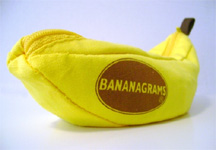
Jan 12th, 2010
Welcome to Part 2 of the 2 Part Holiday Game Recap!
Another awesome game I had played before but picked up over the holiday is Bananagrams. I was first introduced to it by my cousin and his (then) fiancee. They love it so much they gave it as gifts to all their wedding party.
A fairly new game, Bananagrams came out in 2006, and it's usually billed as "Scrabble without the board". That is a fairly accurate description, however there is one other large, very large, difference between Bananagrams and Scrabble. Bananagrams is real-time, where as Scrabble is turn based.
What does that mean exactly? Well, in Scrabble, you're using letters to build a cross-word like structure on a single board, taking turns with the other players to place words. In Bananagrams, you each have your own crossword, that you can rearrange at any time and build as fast as you can build.
Let's go into more detail. All players take a number of letters when the game starts, and the remaining letters are left in the center. You all start making your crosswords at the same time. When you've used up all your letters, you shout "Peel!" and you take another letter from the center, and everyone else *must* also take a letter. Then, when you've assimilated that letter, you shout "Peel!" again, and the process continues. When there aren't enough letters left in the middle for everyone to take one, instead of shouting "Peel!" you shout "Bananas!" and you win.
If you are ever stuck with a letter you don't want, like a Q with no U or a Z or something, you can shout "Dump!" and exchange the troublesome letter, face down, for three new letters. The game is interesting because you'll get someone on a roll, whose built a nice robust crossword, and then they can find easy places to put the next few peels they get, they're on a roll. Every one else is not pleased at the amount of letters they have to take, but then the peeler hits a J or an X or something and is stymied. Meanwhile, the extra letters actually helped out someone else, and they complete their crossword and shout "Peel!" themselves.
The pacing is really good, because in the beginning, you have a whole lot of letters and you build words quickly. However, later in the game, you become hesitant to destroy what you've already created, so you sit there and try to work those new couple letters into the existing structure, in vain. What you should really do is consider reworking or maybe even starting over, concentrate on building longer words that will support smaller quicker words later on.
An amazingly simple and versatile game, Bananagrams is quick to learn, and scales from 2 players to 8 players easily. The most I played with was 11, and that was stretching it. I feel 3-7 is the sweet spot. The "hands" tend to go pretty quick if you have more people, actually, the game feels very different when you play with 3 versus when you play with 7. It's really quite enjoyable. Plus, the game comes in a fun cloth banana package, so it's got that going for it too.
Till next time, have fun out there!
Game Info
Name: Bananagrams
Ages: 7+
Players: 1-8
Playing time: 15 minutes
Price: $15
Designer: Abe and Rena Nathanson
Publisher: Bananagrams / Kosmos
First Published: 2006
Link: http://www.bananagrams-intl.com/index-us.asp
GAME NIGHT: SET

Jan 11th, 2010
Welcome to Part 1 of the 2 Part Holiday Game Recap!
Set is a compact card game that I have been playing for a couple years now, but never actually owned. This year's office gift exchange yielded my very own copy of Set, huzzah!
Originally published in 1988, Set has stood the test of time very well. It continues to be a very fun and intriguing game. The concept is simple. Twelve cards are placed on the table and players look at that them until someone finds a set, then they yell "Set!" and pick up the cards. Three more cards are dealt and play continues.
"What is a set?", you ask. Well, therein lies the gameplay. You see, each card in the deck contains 1, 2, or 3 shapes. There are 3 types of shapes, 3 colors, and 3 shadings (outline only, semi-shaded, and totally filled in). Thus you have four attributes: number, shape, color, and shading. A set is a group of three cards whose attributes are either all the same or all different.
"What?!", you ask. Well, ok, think of it this way. If all three cards have the same number of objects, but different shapes, shadings, and colors, then they're a set. If two cards have a common attribute that is not shared by the third, they are not a set.
I know it sounds confusing, but the game does a really good of introducing you to the concept. It is packaged such that all the solid shaded cards are together and you can play a practice hand where you only use solid shaded cards, effectively eliminating one of the attributes. Then, when you feel ready, you can add the other shadings in and play the full game.
What ends up happening is everyone is staring at a group of cards, intently. All of a sudden someone yells "Set!" and then proves to the others playing it is, indeed a set, then they take those cards and redeal three new ones. Usually there will be a flurry of activity at the beginning as people sweep up the "easy to see" sets, then things get more quiet and everyone analyzes the field. Every Set you get is worth a point, if you cry Set on a non-set, then you lose a point. I usually play you can't go negative : )
If there is ever a field where no Set is found, and all players agree on that, then 3 more cards are dealt and play continues. When the deck is gone, people tally up their points and a winner is crowned!
Set is great because it is easy to travel with, expands from 2 to 8 or more players easily, and has a broad age range. It can be a little frustrating for the real young kids, but I find it depends a lot, I think a 6 or 8 and up rating is not out of the question. The box is comes on has all kinds of Sets depicted on the outside to help teach people what a Set is and what a Set isn't.
It's also very interesting, at the end of the game, to look at the Sets people have gotten. I tend to look for Sets with a 1,2,3 pattern or where all attributes are different. Some people really concentrate on Shading, and some on Color... it's kind of fun to analyze that aspect of the game. What kind of Set player are you?
Till next time, have fun out there!
Game Info
Name: Set
Ages: 7+
Players: 1-8ish
Playing time: ~30 minutes
Price: $10
Designer: Marsha J. Falco
Publisher: Ravensburger or Set Enterprises, Inc.
First Published: 1988
Link:http://www.setgame.com
GAME NIGHT: PUERTO RICO
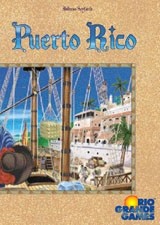
Nov 11th, 2009
Buckle Up Game Night fans, we're going south of the border.
Well, sort of, we're actually going to the Caribbean Sea, to Puerto Rico to be exact. Puerto Rico is an awesome board game, but it is complicated as all get out, so that's why I recommended the buckling.
When you open the box for the first time you will be overwhelmed with game pieces you'll need to punch out of cardboard sheets. Don't worry, while the first time playing is overwhelming, future play sessions will be no problem. In this game you play a plantation owner who spends time growing and processing crops, trading, shipping, and generally building up Puerto Rico while competing with your fellow players.
Setup for this game is intensive, but again, I want to stress that it is totally worth it! If you can somehow play the first time with someone who has played before, it will definitely help, but don't be scared to tackle it yourself. The game ultimately boils down to everybody taking turns carrying out different roles within the colony. These roles are settler, mayor, builder, craftsman, trader, captain, and prospector. Each round everyone will get a chance to choose a role card, taking turns in a clockwise manner.
The cool thing about this mechanic is, say I choose to be the Builder. Since I chose that role, I get a monetary discount when I build and I get first choice of building. However, everyone else still gets to build that turn. The role you pick always benefits you more, but it also benefits everyone else. This leads to interesting dynamics where I may suspect what someone else after me is going to do, so I will pick a role that sets me up to benefit now, and when they go!
Maybe a concrete example will help. See, in Puerto Rico, no crops grow and no buildings do useful things, unless they are manned by a colonist. So, if I know my brother needs people to grow his crops and he will likely choose the Mayor role card to get an influx of colonists, and he is going after me this round, I can pick Settler which gets me another crop, knowing that his Mayor role later on will let me populate my new crop.
Now, this can also be used to mess with other players. If I picked Craftsman instead of Settler, my crops would produce goods, but since my brother's still aren't manned, his won't, giving me the advantage that round. Granted, the order in which people pick roles keeps changing, so I need to make sure I don't make anyone too mad, or they might return the "favor".
Oh, I just have to mention one awesome aspect of the role cards. There are more role cards than people playing (it adjusts depending on the number of people playing during setup) so each round some go unused. These role cards then get a gold doubloon added to them, making them more enticing next round because not only do you get the role bonus, you get the doubloon as well. This sweetening mechanic makes sure that all roles get used frequently, even if the game state is such that one role is prized over another for whatever reason.
The goal of the game is to get Victory Points. These can be earned by shipping goods back to the old world, building up the town's buildings, and by doing other special actions. Puerto Rico has a nice flow to it, early on people are just getting started, choosing different crops and buildings, getting the feel of the game. Then people start honing in on one strategy or another and rounds become these delicate dances of prediction and choices.
Ok, well, like I said, Puerto Rico can be a daunting game to play for the first time, but it is totally worth it! Repeat play trying different strategies is always there, especially since the actions of your fellow plantation owners may force you into rethinking the optimal route to victory.
Till next time, have fun out there!
Game Info
Name: Puerto Rico
Ages: 12+
Players: 3-5
Playing time: ~90 minutes
Price: $30 - $50
Designer: Andreas Seyfarth
Publisher: Rio Grande Games
First Published: 2002
Variations : Puerto Rico Expansion
Link: http://www.riograndegames.com/games.html?id=4
GAME NIGHT: BACKGAMMON
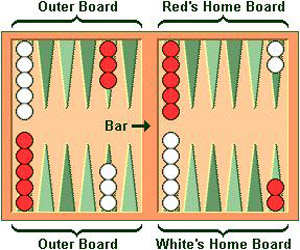
Oct 7th, 2009
Backgammon is a game whose history dates back roughly 5000 years. So, yeah, that makes it the oldest game I've ever reviewed : )
Backgammon is so old, it may be the first game to be mentioned in written history, played by the Sumerians of ancient Mesopotamia. The rules in English were standardized in 1743 by Edmond Hoyle and stayed the same until some changes by Americans in the 1930's.
The game is played on a board, with pieces (checkers/men) and dice. The object is to move your men off the board while evading capture by your opponent. The movement is controlled by the rolling of two dice, and you take turns with your opponent. Setup of the board is shown in the image above. You can purchase very simple boards, extravagent boards, travel boards, or even make your own! You just need a board with the proper markings, 30 pieces (15 of each color), and two dice.
Backgammon is a game of strategy and luck. Each player is trying to move their pieces around the board to their home board and then bear them off. That is, move them fully off the board. You start by each rolling one die. The person rolling higher goes first, and uses that roll. The pieces are moved according to the die roll. If I roll a 2 and a 5, I can move one piece 2, than 5. I can move one piece 5 than 2. Or, I can move one piece 5 and another piece 2. The trick is, my piece can only land on an open point. A point is open if it has less than 2 of the opponent's pieces on it.
Oh, if you roll doubles, you get to use double the pips rolled. For example, if I roll double 6, I get four 6's to use.
Err, ok, enough about rules, let's get to strategy! You see, there is a lot of dice rolling, but there is also a lot of strategy. If you land on a point that only has one of your opponent's pieces on it, that piece gets sent (hit) back to the bar. Being sent back to the bar is bad, you have to start that piece over from the beginning, and you have to do so before moving any other piece. A piece on the bar that can't "enter" holds up your entire game while your opponent moves forward, not cool. So you really want to make sure that you leave your own pieces safe; at least 2 pieces on every point.
Again, the goal is to get all your pieces off the board, or "bear them off". You can only move pieces off the board if all your pieces are in your home board. Then you can use die rolls to move them off, and it doesn't have to be by exact count. For instance, if you have a piece that is 3 points from the edge, you have to have at least a 4 to bear it off, but a 5 or 6 would work too.
Backgammon is another one of those simple games to learn that is difficult to master (a sign of a good game if you ask me!). You can try to build walls in your home board, and then hit your opponent so they stay stalled. You can just go as fast and loose as possible and not send any of your opponent's pieces back, so you know your pieces are safe. There are whole books written on backgammon strategy!
I should mention the doubling cube as well. In the late 20's, early 30's, Americans playing the game decided it needed more gambling infused into it. So they came up with the doubling cube. Backgammon is traditionally played for an agreed stake per point. Each game starts at one point. If you think you are going to win, you can "double" the game, that is, make the game worth 2 points. Your opponent either accepts the higher stakes, or concedes the game right away for 1 point. If your opponent accepts, they get control of the doubling cube, and they can decide to double later if the game swings in their favor. It adds a little extra tension and drama to the game, but you can feel free to play with or without that rule.
So, you ask, what's with the name? Well, at the end of the game, if the losing player has borne off at least one checker, he loses only the value showing on the doubling cube (or he just lost if you're not playing with it). If the loser has not borne off any checkers, he is gammoned and doubly loses! And, of course, if the loser has not borne off any, and still has one on the bar or in the opponent's home board, that player just got backgammoned and loses three times the value! Ooph...
Backgammon is a great game to just play between two people for fun, or, if you're into that whole gambling thing, it supports that play fully. I have many found memories of playing backgammon with my dad, we had a cool leather attache case style set and the feel of the pieces and the satisfying clack sound they made were really great.
Till next time, have fun out there!
Game Info
Name: Backgammon
Ages: 6+
Players: 2
Playing time: ~25 minutes
Price: $0 - $millions
Designer: Some Assyrian perhaps?
Publisher: So many... maybe you!
First Published: 3000BC
Variations : Acey-deucey, Russian Backgammon
Link: http://en.wikipedia.org/wiki/Backgammon
GAME NIGHT: WITS AND WAGERS
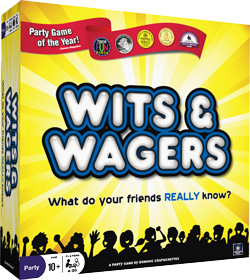
Aug 8th, 2009
Ok, so, you like the idea of trivia games, but you don't know that much trivia yourself? No problem! Wits and Wagers is the game for you! It combines trivia, gambling, and last minute decisions into a super fun party game!
The game says from 3-21 players. That's because playing with less than 3 people is boring, and playing with more than 3 people to each of the 7 teams is a little crazy. I've found that a happy mix is always possible with this game: a couple single person teams, a couple two person teams, etc... that's the way to go.
There are 4 main phases to each round. The question, the guesses, the betting, and the answer.
First, one team reads a question. The team who reads changes each round so everyone gets a chance. Now it's time for the guesses, everyone takes their color-coded tiny whiteboard and writes what they think the answer is. These are questions like, how tall is the statue of liberty, or how many knives did the TSA confiscate in 2004, things like that. You keep your guess secret for now, and put your whiteboard face down in the middle of the betting field. There's a timer so that people don't take forever.
Once every team has their guess in, they are flipped up and some amount of hilarity happens. After the initial snickering is finished, you arrange the guesses in order (all the questions have answers that are able to be ordered). This is where things start getting interesting. You see, since the most reasonable answers tend to be in the middle and the more outrageous answers on the sides, the payout for betting is 2 to 1 in the center, than 3 to 1 around that, all the way up to 6 to 1 for "All Answers Too High". Betting you ask? What betting?
Well, every team has two betting chips, and can earn more from payouts, but you'll always keep your original two (even if you bet completely wrong). You can therefore place two bets each turn. For instance, there's usually an answer or two that feel right, so you may bet on those. However, if everyone bets on one answer, you may move your bet to one of the lonely answers, so if it does pay off, you'll be the only getting chips. Also, if your answer turns out to be closest to the correct answer, than you get a bonus couple of chips.
Ok, all guesses are in, all betting done. The answer is read and the banker (the one in charge of the extra poker chips) pays out all the chips from the successful bets and collects the ones from the unsuccessful ones. The rounds continue until 7 questions have been read, than the one with the most chips wins!
The interesting thing is, that last question, question seven, becomes the All In question. Basically, unless you have a huge lead, it is beneficial to try to bet all your chips on the last question. Of course, everyone else is too, so having the most chips going into that question definitely helps. It really makes the game end on an exciting note!
Wits and Wagers is a really fun and exciting game. They have come out with an expansion pack, though I haven't played with it yet. Some groups hold large Wits and Wagers nights, with projectors and excel sheets, and all. Give it a shot at your next party, birthday, or family game night, I think you'll enjoy yourselves!
Till next time, have fun out there!
Game Info
Name: Wits and Wagers
Ages: 10+
Players: 3-21
Playing time: ~30 minutes
Price: $25-$30
Designer: Dominic Crapuchettes
Publisher: North Star Games LLC
First Published: 2005
Expansions : Expansion Pack 1
Link: http://www.northstargames.com
GAME NIGHT: BLOKUS
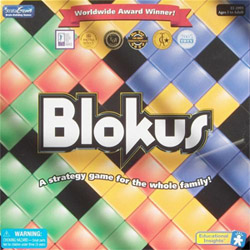
Jul 22nd, 2009
Ok, last month you teamed up to save the world, this week it's every player for themselves!
Blokus is a very colorful game with fun, candy-like pieces that looks very happy and very lighthearted. What lies beneath this facade is a cutthroat game of block placing and back stabbing! Ok, it's not quite that extreme, but it can get pretty interesting.
First published in 2000, Blokus uses a very simple ruleset and simple board with varied pieces to create a compelling and fun game. On your turn you place one of your pieces on the board. The only rule to placing a piece is that it may not lie adjacent to your other pieces, but instead must be placed touching at least one corner of your pieces already on the board. The pieces themselves are squares joined together, think Tetris pieces. Seems simple right?
Well, it is simple, but also devious. See, the board is not really big enough to fit everyone's pieces on while you're vying for space. Also, because, your own pieces can't lie adjacent to each other, it's better to push forward into other players' territory. The goal is to place as many pieces as possible, and it's difficult to do before you run out of options. (I don't think I've ever seen it done, though I have gotten down to only one piece!)
The interesting thing that happens is you'll see treaties made between some players as rivalries arise between others. It's hard to protect your terrirtory from everyone at once, so you'll end up invading your sister's space as you make an agreement with your neighbor to leave each other alone. The colorful pieces start to fill the board, and space begins to get tight. You imagine in your mind where your next piece will go, just to have that spot snatched away from you by the person just to your right.
Now, in theory, according to the box, you can play a solitare version just yourself, trying to get all the pieces on the board. You can also play with 2 players, each taking 2 of the 4 colors. But the real fun is to be had with a 4 person game. Games tend to be quick. From 15-30 minutes I'd say is average.
There are different versions of this game. I actually don't own the original Blokus (though I have played it plenty of times), I own Blokus Trigon. Which is the same game, just with pieces formed from triangles and a non-square board. The different piece interactions get more interesting in this version, and I'd say it's a little more advanced than the original, though still very fun of course! I haven't tried Blokus 3D yet, but if it is anything like the other two, I'm sure it's fun!
So if you're looking for a slightly more competitive game that's fun for all ages, perhaps you should check out Blokus. It's pieces are very cool and fun to play with, the game rocks, and since it's all plastic, it's waterproof!
Oh, one last thing, we're going to be having an actual Greenfield Game Night! So, if you live nearby and are interested in playing some games, come on over to the Greenfield Organization building on Greenfield Ave. on Sunday July 18th at 4pm. I'll bring some games but please don't hesitate to bring some of your own favorites, it should be a really fun time!
Til next time, have fun out there!
Game Info
Name: Blokus
Ages: 6+
Players: 1-4 (4 strongly recommended)
Playing time: ~20 minutes
Price: $25-$30
Publisher: Alary Games
First Published: 2000
Designer: Bernard Tavitian
Variations : Blokus Trigon, Blokus 3D
Link: http://www.alarygames.com
GAME NIGHT : PANDEMIC

Jun 11th, 2009
Ready to save the world? I hope so!
This is definitely the newest game I've discussed. Hitting the board game scene last year, Pandemic has already won 6 awards including Games 100's Best Family Game. That said, what do I think of it? I love it! There are two main reasons: it's cooperative and it's really well designed!
So what is this seemingly great game with the ominous title? Well, the short quote is: "Four diseases have broken out in the world and it is up to a team of specialists in various fields to find cures for these diseases before mankind is wiped out." Hummm... kind of deep stuff for a board game isn't it? Well, yes, but that just makes it all the more engaging!
The board of Pandemic reminds me of Risk's board, only more recent. Populated cities are highlighted with routes to and from each other. As each turn passes, the four deadly diseases spread from city to city using a really cool card mechanic. There are two decks of cards in Pandemic, the Player Cards and the Infection Cards. Infection Cards are used to, well, infect the cities. When you draw a city's card, you put one infection cube on that city. If a city ever reaches 4 cubes, it causes an outbreak which causes the disease to spread one cube's worth into all the surrounding cities. Hold on though, I'm getting ahead of myself...
Pandemic is a cooperative game. What does that mean? Well, it means the players are working together vs. the game, in this case, the diseases. The spread of disease is built ingeniously into the drawing of cards and it is up to the players, each of which has a special ability, to stop it and save the world! The five roles are: Dispatcher, Operations Expert, Scientist, Medic, and Researcher. I won't get into the abilities or strategies here, but suffice it to say, the game is very different depending on the roles being played. During gameplay you are constantly discussing strategy with your teammates. Things like: "Ok, I'll move here and heal this city." "Perfect, that will let April fly me to you so I can cure blue on my turn!" "Done!"
Each turn has three parts. You use your action points, you draw your new Player Cards, and you play the role of the Infector. Action points are what allow you to move your pawn between cities, heal people, trade cards, and cure diseases. This is when the magic happens, when you put all your minds together to come up with an efficient plan of disease eradication!
Player Cards serve three purposes. First, they allow you to move directly between cities and create research stations, but you have to discard them to do this. This is balanced by their second function. You see, to cure a disease, you need have five cards of the same color and be at a research station; and that is the goal of the game, to cure all four diseases. The final purpose of Player Cards? Well, Epidemics lie within the Player Card deck.
You see, during the last phase of each turn your draw a number of Infector Cards, and infect those cities listed on the cards. Normally this isn't a big deal, because, well, there a lot of city cards and each city only gets infected by one cube of one virus. Epidemics change all this. When a player draws an Epidemic card from the Player Cards, it causes a new city to explode with three cubes, but it also causes you to shuffle and put back on the top of the deck all the Infection Cards already used. That makes sure that cities already infected will become more infected, leading to outbreaks. Did I mention that when 8 outbreaks have occurred, you lose? In fact, the difficulty of the game is directly linked to how many Epidemic cards you shuffle into the deck at the beginning. In an "Introductory" game you use 4 Epidemic cards, a "Normal" game uses 5. And, in a "Heroic" game, you use all 6 Epidemic cards.
Wow, this is getting long and complicated, and I'm not going to lie to you, when you first open the box you will be overwhelmed by all the pieces and cards within. But don't despair! The instructions are VERY good and easy to understand. There are even cheat-sheet cards that each player can keep with them as they play. I have played this game many times with new players, and while some have seemed daunted at the beginning, they all have loved it by the end are always eager to play again! The cooperative nature allows new players and seasoned players to work together and you are always interested in what's going on, even when it isn't your turn.
Ok, let's recap. Disease is sweeping the Earth, it's up to you and your friends to travel the globe helping inflicted cities and finding cures. It's hard to describe the incredible feelings this game conjures up. You really, really feel invested in it. One particularly exciting game I played came down to one draw. We knew a city card that would lead to a cascading 3-tiered Outbreak was one of 6 cards we had just placed on the deck, and we had to draw 3 of them. If we didn't draw the deadly city, on the next turn our Scientist would cure the final disease and we would win. If we did draw it... well, let's just say the results would be catastrophic! Everyone hushed as the Dispatcher flipped over the cards... good... good.... WE WIN!!!! It was awesome!
Till next time, have fun out there!
Game Info
Name: Pandemic
Ages: 10+
Players: 2-4
Playing time: ~45 minutes
Price: $28-$35
Designer: Matt Leacock
Publisher: Z-Man Games
First Published: 2008
Expansions : Pandemic : On the Brink
Link: http://www.zmangames.com/boardgames/pandemic.htm
GAME NIGHT: THE AMAZEING LABYRINTH
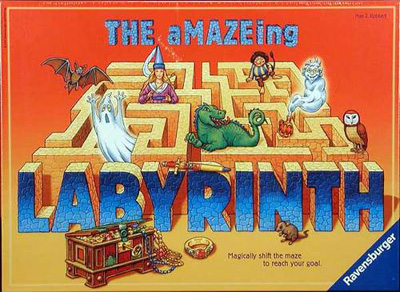
May 4th, 2009
Want to get lost in game night? Well then, I've got the game for you! The aMAZEing Labyrinth!
Ok, bad puns aside, The aMAZEing Labyrinth (referred to as TAL from now on) is an engaging game with a fun mechanic at its heart that serves its theme very well. In TAL you play an explorer in an enchanted labyrinth, trying to "reach all the mysterious objects, treasures, and creatures assigned to you."
So how does this maze work? Well, that's the really cool part. The TAL board has 16 maze pieces affixed to it. These pieces can't physically move and have the starting squares and many of the treasure icons on them. You shuffle the remaining maze pieces and place them randomly on the board. Each maze piece has an arrangement of walls and paths on it; there are T's, straight pieces, intersections, and corners. By placing the pieces on the board you form an intricate labyrinth. The players (up to four) place their pawns on the color-coded corners. There is one maze piece leftover, and the person who goes first gets to place it. By sliding an entire row or column of maze pieces one space, the turn player can fit their new piece onto the edge of the labyrinth. Now, keep in mind, sliding all the pieces in that row or column changes the paths that exist throughout the labyrinth. Ultimately, this game is about creating paths from your pawn to the mysterious treasures you're trying to collect.
At the beginning of the game you shuffle and deal out treasure cards. Each treasure card is unique and has an image of one of the icons on the puzzle pieces. There are things like bags of gold, keys, jewels, swords, maps, and even ghosts. The goal of the game is to move between the treasures on your cards, each time you arrive at a treasure you turn over that card, revealing the treasure to everyone else. You see, as you're searching for the jewels, your opponent may be searching for the keys. No one knows what anyone else is looking for, but you can sometimes figure it out by the paths your opponent tries to create. Part of the fun of the game is attempting to build paths for yourself while moving or destroying paths your opponents are trying to use.
At first the maze is very disjoint and there are not very large paths. Every turn starts by moving the maze. Push your piece into the board to make a path for yourself or block one of your opponent's. The only rule is that you can't undo the move of the person right before you. After moving the maze, you move your pawn. You can move as little or as much as you want, assuming there's a path for you to move along.
As play progresses, paths start to form, and people start mixing and matching their paths with other's. The pace of the game picks up and people start finding more and more of their treasures. Now, you only ever know the next treasure you're looking for, you're not allowed to plan ahead by looking ahead in your treasure pile. It's very fun to think of tricky ways of moving the maze; for instance, if you move your piece off the board, it will appear on the opposite side, a quick way to get to an entirely different part of the labyrinth!
The aMAZEing Labyrinth has spawned many different versions, both board and card games. While I haven't played all of them I recommend starting with the original, it's the most "pure". The aMAZEing Labyrinth is fun for the whole family and is relatively quick to play. It works best with 3 or 4 players, but 2 is certainly doable.
Till next time, have fun out there!
Game Info
Name: The aMAZEing Labyrinth
Ages: 6+
Players: 1-4
Playing time: ~20 minutes
Price: $20-$35
Designer: Max J. Kobbert
Publisher: Ravensburger
First Published: 1986
Variations : Master Labyrinth, Junior Labyrinth, 3-D Labyrinth, Secret Labyrinth, Lord of the Rings Labyrinth, Labyrinth Treasure Hunt
Link: http://www.ravensburger.com/usa/home/index.html
GAME NIGHT: CATCH PHRASE
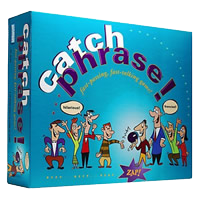
Mar 23rd, 2009
Oh man, let the craziness begin!
Catch Phrase is another of one of my all time favorite games! It's an incredibly simple game to learn and the number of people who can play it expands very easily. The rules are very simple. Everyone playing sits in a (rough) circle and are divided into two teams. Every other person is on the same team. Yes, this does mean you need an even number of people to play... generally this limitation works itself out, although sometimes you have to have someone be on both teams... and while not ideal, that does sort of work.
Anyway, the game comes with a disk that you pass around the circle. When you get the disk, you push a button and a word shows up in a little plastic window, your goal is to make the other people on your team guess that word. You can talk, you can gesture, you can make noises... it is however, against the Catch Phrase rules to say a word that rhymes, give the first letter, or say part of the guessing word. Anything else goes! Once your team guesses the word, you pass the disk to the next person in the circle.
Meanwhile, there's a timer counting down a random number of seconds in the center. When that timer goes off, the team that is holding the disk is in trouble, because the other team gets a point. Think of it like hot potato. There is a game board with spaces marked on it and two pawns that move along it to represent the two teams.
Also, if I'm halfway through getting my team to guess a word and the timer goes off, the opposing team can make a guess and steal another point, for a total of two, that round.
The really ingenious part of this game is the timer. It quickens its pace a couple of times, and since the time is random, you never know when it will end. When it speeds up, everyone gets more frantic. Gestures become wild, voices raise, excitement escalates! If it speeds up and holds it for awhile, oh man, things get fun! Then again, sometimes it won't even get to its fastest pace, you'll think you have all the time in the world and it will buzz, and you'll be left holding the disk as the other team laughs and laughs.
I find a group of 6 or more is the best, though it will work with 4. You can play till you get to the end of the board, first team wins. But you'll often find you're playing game after game (best of 3, best of 5, no, best of 7!!). Eventually you'll just play to play, until everyone is so exhausted they stumble home with happy looks on their faces.
There is an electronic version of the game now available. The original version had paper discs that would physically spin inside the disk you pass around. They would have to flipped over and changed out when you use up all the words on them. The electronic version has a database of thousands of words, and does away with the board and timer because it keeps score and it is the timer as well. In practice, I actually prefer the original version. The occasional lull provided by changing the discs out is welcome and can also build tension. Many times the timer will be about to run out, and you'll get to a word you've done before, and call out "Wait, wait! Time to switch discs!!" Hilarity ensues. Also, the physical board is always fun, and I like having the timer in the center. Of course, the electronic version is more compact, has less pieces, and you don't have to worry about switching discs.
The original is usually found for about $20 and the electronic around $30. Catch Phrase is a wonderful family/group/party game that is very easy to teach and very fun!
Till next time, have fun out there!
Game Info
Name: Catch Phrase
Ages: 9+
Players: 4-Any even number
Playing time: However long you want!
Price: $20-$28
Publisher: Parker Brothers / Waddingtons Games (now both Hasbro)
First Published: 1994
Designers: ???
Variations : Electronic Catch Phrase
Link: http://www.hasbro.com/
GAME NIGHT: BOHNANZA
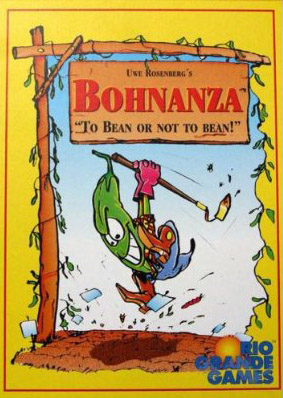
Jan 28th, 2009
Ready for more games? I know I am!
I don't know about yinz, but I enjoy a good game of German bean farming every now and then, and that's exactly what Bohnanza gives you! Bohne, German for bean, provides the root for an extremely fun game.
First published in 1997, Bohnanza is, I believe, a game firmly settled in the "trading" genre of games. That is, there is a lot of trading and bartering that goes on back and forth between players. The goal of the game is to earn coins for harvesting beans. That's right, beans. In the normal game there are Coffee, Wax, Blue, Chili, Stink, Green, Soy, Black-eyed, Red, Garden, and Cocoa Beans.
Players have a hand of cards (beans), and on their turn they plant beans, trade beans, and draw new beans. The beans each have their own rarity. For instance, Blue Beans are very common, and therefore you need to plant a lot of them to get the coveted gold coins. Garden Beans however are very rare, so each Garden Bean is worth a gold coin, assuming you're lucky enough to draw or a shrewd enough trader to get them. In general, the more beans you have, the more gold you will receive when you harvest the beans. Take Black-Eyed Beans, harvesting 2 beans gets you one gold, 4 beans two gold, but 5 beans equals three gold. So if you can hold out for 5, you're making good bean-money!
You start the game with two bean fields you can plant. That means you can only have two types of beans planted at a time, if you want (or have to) plant a third, you must harvest one. And since harvesting at the optimal number of beans is key, you'll want to manage your planting schedule. One of the interesting game mechanics that Bohnanza uses concerns your hand of cards. You are not allowed to reorder your hand. This comes into play on your turn, when you have to plant the first bean in your hand. You want to make sure that the next bean in your hand is one you want to plant... so how do you do that?
With trading! Every turn, the turn player can trade with everyone else. This is where beanfield diversification comes in handy! If mom is planting Blue and Chili, I don't want to compete, so maybe I'll plant Stink and Red. That way, we can help each other out when it comes to trading. In fact, a large part of trading is usually gifting. That is, I really have nothing to offer in exchange, but Dad really needs to get rid of his Stink Bean before his turn, so he'll gift it to me in exchange for maybe some goodwill later on in the game. Trust me, it's very fun!
Another cool mechanic the game has is the way the gold coins and length of game interact. You see, every bean card has a gold coin on the back of it. So, when I harvest 3 beans to get 1 gold coin, I simply discard two of the beans and keep one in my gold coin pile, upside down. This does two things, it lets me keep track of my gold, and it takes cards out of the system. When the draw-deck is empty, you shuffle the discard deck and keep playing. After the second shuffle, when the (now much smaller) pile runs out, the game ends. This builds a very fun interest curve, where the first round takes a nice long time, everyone enjoying themselves and trading very freely. The second round goes faster, and people start to think about their trades more. The third (and final) round goes fast. Players think about the trades they've made, who they "owe" beans from gifts earlier, and in general become more stingy, all leading up to that final turn when people try to frantically plant and harvest whatever they can before that final card is drawn and the game ends.
I find a group of 4-5 is best, but the game claims to and truly does support 3-7. There are rules for a 2 player game, but it doesn't work quite as well in my opinion.
The game has a couple different variations. There are two expansions to the original which add other types of cards and different rule sets. Also, the Fan Edition is very fun, it is basically the original version but every bean illustration is different and hand drawn by a fan of the game; over 200 fans from all around the world drew beans and make the set very colorful and even more amusing! (However, the fan edition does not include the Cocoa, Wax, and Coffee Beans...)
The original, which can still be found in stores and online, is around $20. The Fan Edition can usually be found for $15-$20 and the expansions are around as well. Games Unlimited on Murray carries the game locally.
Bohnanza is a great "trading" game with a fun theme and graphics to go along with it. Play it with family or friends and watch with amusement as beans that are traded freely at first become harder to come by as the game is about to end. After all, German bean farming is a tough business!
Til next time, have fun out there!
Game Info
Name: Bohnanza
Ages: 8+
Players: 3-7
Playing time: ~45 minutes
Price: $15-$20
Publisher: Rio Grande Games
First Published: 1997
Designers: Uwe Rosenberg
Variations : Fan Art Edition
Expansions: Bohnaparte and High Noon
Link: http://www.riograndegames.com/games.html?id=36
GAME NIGHT: APPLES TO APPLES
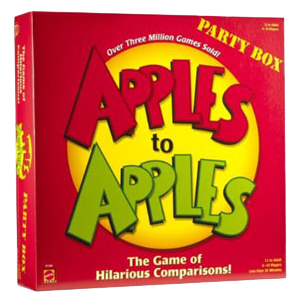
Dec 4th, 2008
Hi everyone, Shawn here, and I’ll be bringing you posts on Game Night!
What is Game Night you ask? Well, I am of the opinion that games are fun. I know, it’s a crazy idea, but I stand by it. However, people are busy these days, they don’t have time to waste on bad games or weird games or games they might not be interested in. That’s where this article comes in; I am going to review and recommend fun games that you and your family and friends can enjoy.
Ok, I’ll get things started with a great family and party game that’s been around since 1999, Apples to Apples! This is “The Game of Hilarious Comparisons” and it’s been one of my favorites since I picked it up in 2001. I love Apples to Apples for a couple of reasons. First off, it’s very fun, the level of hilarity that is reached while playing this game is quite high. Second, it’s extremely accessible, new players learn to play within seconds and the number of players playing can be changed while the game is going on, so if you start playing it at a party, people can join in at any time and pick up the rules instantaneously.
The game’s concept is loosely based on the phrase “That’s like comparing apples to oranges.” You start by dealing red apple cards, which contain nouns, to all the players. Then, one player is chosen as the judge to start (you take turns being the judge, each round the judge switches). The judge flips over a green apple card which contains an adjective. The other players read the cards in their hands, and select one that is described by the adjective.
For example, if the green card is “Magical,” players may put down “Remote Controls,” “Disneyland,” “Yellowstone Park,” “Oprah Winfrey,” and “Leonardo Da Vinci.” Here’s the trick, the judge is deciding which red card fits the best, and whoever’s card the judge picks, gets to keep the green card. At the end of the game, the person with most green cards wins. The beautiful part of this game is that the judge changes, so if your brother is judge, and he loves gadgets, he may think “Remote Controls” are “Magical.” However, your friend from across the street may love “Yellowstone Park” and choose that one. Clearly your kid sister loves “Disneyland” and thinks that it is “Magical.” This game is all about reading the judge and applying the most perfect card for him/her. Sometimes your hand may not have the best selection of cards so you put down something crazy, it just adds to the fun when that card is revealed. You never know, maybe someone thinks “Lint” is “Magical!”
After playing a couple of times, you’ll learn each player’s “trump card,” that is, a card that they love so much or think is so funny, that they’ll inevitably choose it. For me, it’s “Charging Rhinos.”
I find a group of 5-7 is best, but the game scales incredibly well. There are also many variations: you can deal out green cards instead of red, use the opposite instead of synonyms, etc.
The game has had a couple different forms. The original set, which can still be found on ebay for $11 or so, won Party Game of the Year and a Mensa Select award. They’ve since added more cards to the mix with different expansion packs. The main product now is the “Party Box” which can be found on amazon.com for $20 or stores for $27.
Apples to Apples is a great game for parties, your family’s game night, or for game night with your friends. Bring it to that next family reunion and find out what grandma thinks is “Hilarious!”
Til next time, have fun out there!
Game Info
Name: Apples to Apples
Ages: 12+
Players: 4-10
Playing time: 20-30 minutes
Price: $20-$30
Publisher: Out of the Box
First Published: 1999
Designers: Mark Alan Osterhaus and Matthew Kirby
Variations: Apples to Apples Kids and Junior
Make sure you check out the publisher’s site and fan page!